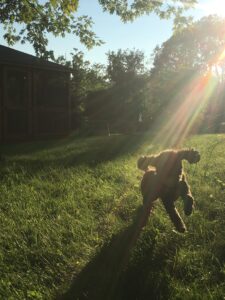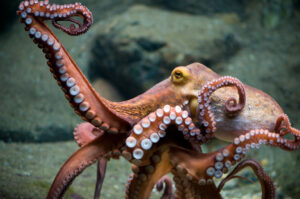How well do we really know our animal siblings?
A year or so ago, I listened to this RadioLab episode on animal intelligence—and it blew me away. Not only was it funny and entertaining, it introduced an idea I had never thought of. Dan Engber, a science writer, argued that the way we humans measure the intelligence of our fellow animals is by measuring their ability to do things that we can do.
Engber brings up the idea that we humans seem only able to view animal intelligence through the lens of our own values.
The latest tidbit on dog intelligence, for instance, is that dogs are as smart as 2- to 2½-year-old children. But this study was conducted by interviewing dog obedience judges, and among its evidence is the number of words dogs can learn. We repeatedly measure the intelligence of animals, in other words, by how well they learn and respond to our commands rather than something more within their realm of importance.

Other studies use the mirror self-recognition test, which rates animal intelligence on whether or not they are able to identify the shape in the mirror as a reflection of themselves. What this test fails to consider is that a nonhuman animal would hardly ever face a scenario like this in the wild, and thus, that it isn’t what their biology values.
The way we get to know our companions isn’t centered around understanding but comparing—which, at its core, feels like fishing for more ways to prove human superiority.
This battle for the “last distinction” that divides humans from the rest of the animal kingdom is one that white European writers and scientists have been waging for centuries. Our language mastery, our capacity to feel emotion, and even our tool-making abilities have all been considered in this obsessive comparison.
Crows, for one, have already proven that humans are not the only creatures that use tools. And many different types of animals, from birds to beluga whales, have shown ability to mimic human language. Bees, apes, dolphins, and even prairie dogs are thought to have their own language-like capabilities.
So how should we measure animal intelligence? Carl Safina has a few ideas. Researchers nowadays are putting dogs through M.R.I. machines to measure brain activity, but Safina, an Ecologist, claims that from simply observing dogs we can safely conclude that they have memory, a range of emotions (including love), and even imagination.

Another case study is the octopus. Starting as early as the 90s and continuing into the 2010s, research on octopus intelligence has proven octopuses to be not only surprisingly intelligent, but also mischievous in personality. One octopus was caught squirting water to at the lights in the aquarium to shut them off (purely to get a reaction out of his keepers). Here’s an octopus pretending to be a fish. There’s even an octopus that fell in love with Mr. Potato Head.
The other thing the RadioLab episode suggested was that we need more flexibility in our definition of intelligence.
Laurel Braitman argues that social ocean mammals, and specifically sperm whales, may experience an extreme form of groupthink—even a “groupfeel” as a result of their complex echolocation communication systems and powerful social bonds.
She speculates that this groupfeel is why pods of dolphins and whales will defend swimming humans from shark attacks or rescue them from drowning. Or why a pod of sperm whales adopted a deformed and abandoned dolphin.
This decision-making process might be less of a conversation and more like the experience of a collective mind. This argument is supported by research on swarm intelligence, which is the rapid information flow between members of a social group with no one lead individual conducting it.
Swarm intelligence is something humans may never come close to experiencing. Heck, we hardly even understand it as it is. But the interconnectivity of it elicits a metaphor for ecosystem behavior: every species in an ecosystem is dependent on all the others, and there’s no “most important”—despite what we humans may have been led to believe.
Perhaps with a more holistic, multispecies understanding of intelligence, we can remember that we are only a small part of a greater web of life, and that we have a responsibility to treat our fellow creatures with respect and empathy. Our problems might seem a lot smaller if we let go of our need to be the best or the smartest, and look at our planet with an ecosystem lens.

Wow. How is this a top google result on the question of animal intelligence. First the author digs into racial issues, calling out “white” European scientists. How is their ethnicity relevant to the issue of animal intelligence? They created the best scientific model they were capable of, at the time, with available resources.
And then the big reveal comes.. the author has criticized a few (very basic) existing methods like the mirror test (ignoring more complex models like EQ) and says “woah, watch out, this Salina person has the answer! It’s… (drumroll here) just looking at the animals! You can see emotions and stuff lol!”
Cutting edge observations. Science dealt a crushing blow. Author totally slams modern science with this one simple trick! European white scientists sent reeling by the incredible intellect behind this new technique!”
I understand this is not some professional scientist offering insight. It’s some student that is just writing something they find intriguing. Ok great. I don’t even argue with the premise that we need better ways to measure animal intellect.
What we really need isn’t a perfect way to measure it though, such a thing does not exist and will never exist. We need minds that will explore and add to the discussion. We need to continue to improve. Not waste our minds criticizing scientists of the past. At least they DID something.
I just hardly think “hey just like, look at them yo. Those are emotions and stuff” really contributes anything to the conversation. We all had family pets. We know they have emotions. We need a quantifiable and measurable methods. Real data.